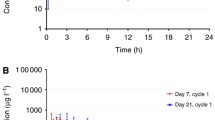Abstract
A randomized, multicenter, open-label, phase 3 study of patients with progressive, recurrent glioblastoma multiforme (GBM) for whom front-line therapy had failed was conducted. This study was designed to determine whether combination therapy with imatinib and hydroxyurea (HU) has superior antitumor activity compared with HU monotherapy in the treatment of recurrent GBM. The target population consisted of patients with confirmed recurrent GBM and an Eastern Cooperative Oncology Group performance status of 0–2 who had completed previous treatment comprising surgical resection, irradiation therapy, and first-line chemotherapy (preferably temozolomide (TMZ) containing regimen) and who have progressed despite treatment. If first-line chemotherapy did not contain TMZ, a second completed chemotherapy was acceptable. The primary efficacy parameter was progression-free survival (PFS). The primary comparison of combination therapy versus monotherapy for PFS was not significant (adjusted P = 0.56). The hazard ratio (HR) (adjusted HR = 0.93) was not clinically relevant. The median PFS for the combination arm was low at 6 weeks and similar to the median PFS in the monotherapy arm (6 weeks). The 6-month PFS for the two treatment groups was very similar (5% in the combination arm vs. 7% in the monotherapy arm). No clinically meaningful differences were found between the two treatment arms, and the primary study end point was not met. Among the patients receiving imatinib, no adverse events were reported that were either previously unknown or unexpected as a consequence of the disease.



Similar content being viewed by others
References
Stupp R, Mason WP, van den Bent MJ et al (2005) Radiotherapy plus concomitant and adjuvant temozolomide for glioblastoma. N Engl J Med 352:987–996. doi:10.1056/NEJMoa043330
Sathornsumetee S, Reardon DA, Desjardins A et al (2007) Molecularly targeted therapy for malignant glioma. Cancer 110:13–24. doi:10.1002/cncr.22741
Joensuu H, Puputti M, Sihto H et al (2005) Amplification of genes encoding KIT, PDGFRalpha and VEGFR2 receptor tyrosine kinases is frequent in glioblastoma multiforme. J Pathol 207:224–231. doi:10.1002/path.1823
Buie LW, Valgus JM (2008) Bevacizumab: a treatment option for recurrent glioblastoma multiforme. Ann Pharmacother 42:1486–1490. doi:10.1345/aph.1L030
Raymond E, Brandes A, Van Oosterom A et al (2004) Multicentre phase II study of imatinib mesylate in patients with recurrent glioblastoma: an EORTC:NDDG/BTG intergroup study. Proc Am Soc Clin Oncol 23:107 abstract
Wen PY, Yung WK, Lamborn KR et al (2006) Phase I/II study of imatinib mesylate for recurrent malignant gliomas: North American Brain Tumour Consortium Study 99–08. Clin Cancer Res 12:4899–4907
Canute GW, Longo SL, Longo JA et al (1998) The hydroxyurea-induced loss of double-minute chromosomes containing amplified epidermal growth factor receptor genes reduces the tumorigenicity and growth of human glioblastoma multiforme. Neurosurgery 42:609–616. doi:10.1097/00006123-199803000-00031
Wen PY, Kesari S (2008) Malignant gliomas in adults. N Engl J Med 359:492–507. doi:10.1056/NEJMra0708126
Dresemann G (2003) STI 571/hydroxyurea in progressive, pretreated glioblastoma (GB) patients (pts.). Proc Am Soc Clin Oncol 22:116 ASCO abstract 465
Dresemann G (2004) Imatinib (STI571) plus hydroxyurea: safety and efficacy in pre-treated, progressive glioblastoma multiforme (GBM) patients (pts). Proc Am Soc Clin Oncol 23:119 abstract
Dresemann G (2005) Imatinib and hydroxyurea in pretreated progressive glioblastoma multiforme: a patient series. Ann Oncol 16:1702–1708. doi:10.1093/annonc/mdi317
Reardon DA, Friedman AH, Herndon JE et al (2004) Phase II trial of imatinib mesylate plus hydroxyurea in the treatment of patients with malignant glioma [Abstract T-47]. In: Society for neuro-oncology 9th annual meeting, Toronto
Reardon DA, Egorin MJ, Quinn JA et al (2005) Phase II study of imatinib mesylate plus hydroxyurea in adults with recurrent glioblastoma multiforme. J Clin Oncol 23:9359–9368. doi:10.1200/JCO.2005.03.2185
Schrell UM, Rittig MG, Anders M et al (1997) Hydroxyurea for treatment of unresectable and recurrent meningiomas. II. Decrease in the size of meningiomas in patients treated with hydroxyurea. J Neurosurg 86:840–844
Macdonald DR, Cascino TL, Schold SC Jr et al (1990) Response criteria for phase II studies of supratentorial malignant glioma. J Clin Oncol 8:1277–1280
Raymond E, Brandes AA, Dittrich C et al (2008) Phase II study of imatinib in patients with recurrent gliomas of various histologies: a European Organisation for Research and Treatment of Cancer Brain Tumor Group Study. J Clin Oncol 26:4659–4665. doi:10.1200/JCO.2008.16.9235
Pursche S, Schleyer E, von Bonin M et al (2008) Influence of enzyme-inducing antiepileptic drugs on trough level on imatinib in glioblastoma patients. Curr Clin Pharmacol 3:198–203. doi:10.2174/157488408785747656
Acknowledgments
This paper has been submitted on behalf of all investigators and colleagues involved in the Ambrosia study. We are grateful to the following colleagues who agreed to act as investigators on the trial: Dr Erika Kettner MD, Staedtisches Klinikum, Magdeburg, Germany; Dr Kea Franz, MD, University Clinic, Frankfurt, Germany; Dr Marion Ritterodt, MD, Kliniken der Med. Hochschule, Hannover, Germany; Dr Sudarshan Selva-Nayagam, Royal Adelaide Hospital, Adelaide, Australia; Prof Klaus Koeffken, Friedrich-Schiller Universitaet, Jena, Germany; Prof A Sepehrnia, Clemenshospital, Muenster, Germany; Prof Bernhard Woermann, Staedisches Klinikum, Braunschweig, Germany; Prof Friedrich Weber, and Dr Ulrich Langenbach, Klinikum Saarbruecken, Saarbruecken, Germany; Dr Hartmut Döhner, University Clinic, Ulm, Germany. In addition to the above investigators, we wish to thank Steven Green, Novartis Pharma Basel, for excellent statistical support; Thierry Gorlia, EORTC, Brussels, for acting as Independent DMC statistician; Dr Martin van den Bent, Daniel den Hoed Oncology Center, Rotterdam, The Netherlands, Dr Alfred Yung, M.D. Anderson Cancer Center, Texas, USA, and Dr Riccardo Soffietti, Department of Neuroscience and Oncology, University of Turin, Italy, for being independent clinicians on DMC; and Dr Greg Sorensen, Massachusetts General Hospital, Boston, USA. We thank as well Dr David Reardon, Duke University Medical Center, North Carolina, USA, for his numerous valuable suggestions.
Author information
Authors and Affiliations
Corresponding author
Rights and permissions
About this article
Cite this article
Dresemann, G., Weller, M., Rosenthal, M.A. et al. Imatinib in combination with hydroxyurea versus hydroxyurea alone as oral therapy in patients with progressive pretreated glioblastoma resistant to standard dose temozolomide. J Neurooncol 96, 393–402 (2010). https://doi.org/10.1007/s11060-009-9976-3
Received:
Accepted:
Published:
Issue Date:
DOI: https://doi.org/10.1007/s11060-009-9976-3




